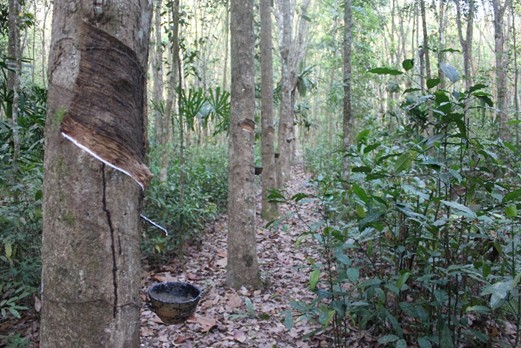Rubber Management Systems: A Progression from Extractive to Regenerative Production
Main Article Content
Abstract
Demand for natural rubber is driving an increase in acreage under production and tonnage of rubber produced. Conventionally managed rubber monocultures have presented multiple ecological, economic, and social risks, and alternative rubber management systems must be explored. The paper outlines a gradient of rubber management systems in the provinces of Phatthalung and Songkhla in Thailand. The field observations and exchanges considering the diversity of practices of various rubber farmers were conducted from October 2020-February 2022. Rubber management systems along a gradient ranging from degenerative to regenerative, suggesting each's key principles, characteristics, and benefits were synthesized to the results. Six rubber management systems were found: monocultural, organic, simple polyculture, complex polyculture, modern jungle, and traditional jungle. Outcomes of rubber production systems include ecological health, economic stability, social well-being, farmer knowledge, and increased relationship with nature based on the rubber regeneration production of conventional systems (monocultural) to complex agroforestry systems (Wanakaset). The continuum of regenerative practices with biological monoculture became a complex polyculture; there is a high level of natural regeneration.
Article Details

This work is licensed under a Creative Commons Attribution-NonCommercial-NoDerivatives 4.0 International License.
References
Warren-Thomas, E.; Dolman, P. M.; Edwards, D. P. Increasing Demand for Natural Rubber Necessitates a Robust Sustainability Initiative to Mitigate Impacts on Tropical Biodiversity. Conservation Letters. 2015, 8(4), 230–41. https://doi.org/10.1111/conl.12170.
Fox, J.; Castella, J-C. Expansion of rubber (Hevea brasiliensis) in Mainland Southeast Asia: What are the Prospects for Smallholders? The Journal of Peasant Studies. 2013, 40(1), 155-170. https://doi.org/10.1080/03066150.2012.750605.
Laurance, W. F; Sayer, J.; Cassman, K. G. Agricultural Expansion and Its Impacts on Tropical Nature. Trends in Ecology & Evolution. 2014, 29(2), 107–116. https://doi.org/10.1016/j.tree.2013.12.001.
Rubber Market Size, Industry Share, Outlook 2020-2027. Available online: www.fortunebusinessinsights.com/industry-reports/rubber-market-101612. (Accessed 11 Apr. 2023).
Stroesser, L.; Penot, E.; Isabelle, M.; Tongkaemkaew, U.; Chambon, B. Income Diversification for Rubber Farmers through Agroforestry Practices: How to Overcome Rubber Price Volatility in Phatthalung Province, Thailand. Annual conference of the International Rubber Research and Development Board. 2016.
Warren-Thomas, E.; Dolman, P. M.; Edwards, D. P. Increasing Demand for Natural Rubber Necessitates a Robust Sustainability Initiative to Mitigate Impacts on Tropical Biodiversity. Conservation Letters. 2015, 8(4), 230–41. https://doi.org/10.1111/conl.12170.
Ahrends, A.; Hollingsworth, P. M.; Ziegler, A. D.; Fox, J. M.; Chen, H.; Su, Y.; Xu, J. Current trends of rubber plantation expansion may threaten biodiversity and livelihoods. Global Environmental Change. 2015, 34, 48–58. https://doi.org/10.1016/j.gloenvcha.2015.06.002.
Singh, A. K.; Liu, W.; Zakari, S.; Wu, J.; Yang, B.; Jiang, X. J.; Zhu, X.; Zou, X.; Zhang, W.; Chen, C.; Singh, R.; Nath, A. J. A Global Review of Rubber Plantations: Impacts on Ecosystem Functions, Mitigations, Future Directions, and Policies for Sustainable Cultivation. Science of the Total Environment. 2021, 796, 148948. https://doi.org/10.1016/j.scitotenv.2021.148948.
Drescher, J.; Rembold, K.; Allen, K.; Beckschäfer, P.; Buchori, D.; Clough, Y.; Faust, H.; Fauzi, A. M.; Gunawan, D.; Hertel, D.; Irawan, B.; Jaya, I. N. S.; Klarner, B.; Kleinn, C.; Knohl, A.; Kotowska, M. M.; Krashevska, V.; Krishna, V.; Leuschner, C.; Lorenz, W. Ecological and Socio-Economic Functions Across Tropical Land Use Systems After Rainforest Conversion. Philosophical Transactions of the Royal Society B: Biological Sciences. 2016, 371(1694), 20150275. https://doi.org/10.1098/rstb.2015.0275.
Reed, B. Shifting from "Sustainability" to Regeneration. Building Research & Information. 2007, 35(6), 674–680. https://doi.org/10.1080/09613210701475753.
Mang, P.; Reed, B. Designing from Place: A Regenerative Framework and Methodology. Building Research & Information. 2019, 40(1), 23–38. https://doi.org/10.1080/09613218.2012.621341.
Tongkaemkaew, U.; Penot, E; & Chambon, B. 2020. Rubber Agroforestry Systems in Mature Plantations in Phatthalung Province, Southern Thailand. Thaksin Journal. 2020, 23(1), 78-85.
Jongrungrot, V. Resilience, various benefits, and constraints of rubber agroforestry systems in southern Thailand. International Journal of Agricultural Technology. 2021, 17(2), 517-534. Available online http://www.ijat-aatsea.com. ISSN 2630-0192 (Online)
Prommee, W. Guidelines for integrated rubber plantation management by planting rubber together with other plants. Rubber Research Institute Rubber Authority of Thailand, 86 pages. Available online: https://www.opsmoac.go.th/songkhla-local_wisdom-files-432891791797. (Accessed 11 Apr. 2023) 2021. (in Thai).
Commons, M. Wanakaset Network Thailand. Available online: https://ecovillage.org/ecovillage/wanakaset-network-thailand/ April 4, 2019. (Accessed 11 Apr. 2023).


